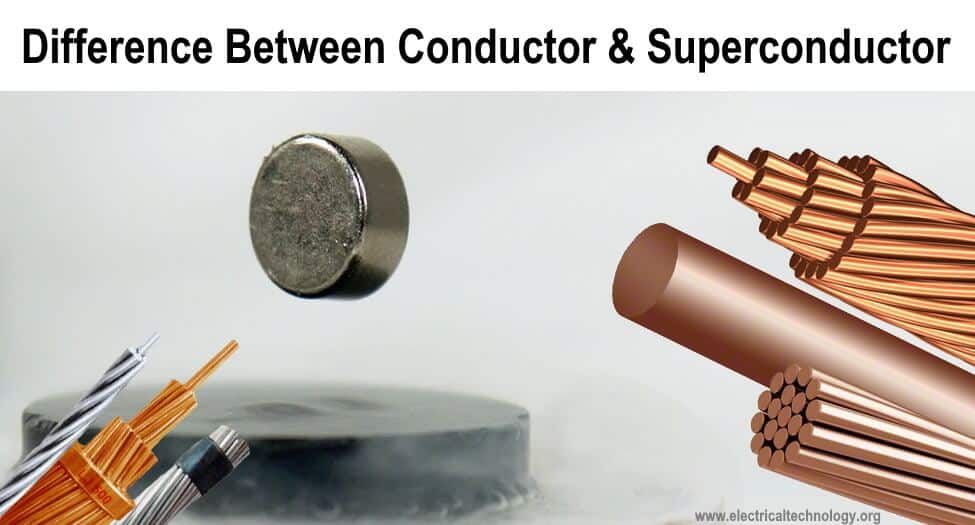Difference Between Conductor and Superconductor
What is the Difference Between Conductor and Superconductor
The main difference between a conductor and superconductor is that a superconductor has zero electrical resistance while conductors have some finite resistance. The superconductor is actually a special type of conductor that achieves superconductivity only when its temperature is brought down below critical temperature.
What is a Conductor?
In Electrical and Electronics engineering, a conductor is a type of material that allows the flow of charge otherwise known as electrical current. Most common electrical conductors are made from metals e.g copper, silver, gold etc. Such materials allow the current flow due to the presence of free electron or ions which starts moving when a potential difference is applied.
Conductor Examples: Copper, Gold, Silver, Aluminum etc.
- Related Post: Difference Between Capacitor and Supercapacitor
What is Superconductor?
A superconductor is a material that exhibits zero electrical resistance i.e. there is no opposition for the flow of electrical current. The resistance causes loss of energy in the form of heat but since there is no resistance so there is no loss of energy inside a superconductor. The resistance is directly proportional to the temperature. But unlike normal conductors whose resistance decreases slowly, the resistance of superconductors falls to zero below a fixed temperature known as critical temperature.
Normal conductors have some constant resistance even when their temperature reaches absolute zero but the superconductor’s resistance abruptly falls to zero below the critical temperature. There is absolutely no resistance.
The superconductivity is a quantum phenomenon that occurs in some special conductors only below the critical temperature. The superconductor experiences quantum locking or levitation inside a magnetic field where it locks its position hovering inside a magnetic field known as magnetic levitation.
Superconductor Examples:
- Mercury behave as a superconductor as it loses all the resistance when cooled below 4.1 kelvin (K).
- 27 Pure Metals known as soft or Class I Superconductors as it identifying characteristics are zero below the critical resistance e.g Aluminum, Zinc, Mercury, Lead etc.
- Class II Superconductors made from alloys known as hard superconductor with higher critical magnetic field such as NbTi (Niobium-Titanium). These superconductors lay in a Vortex State (a mixed state between conductor and superconductor).
- Related Post: Difference Between Voltage and EMF?
Main Differences Between Conductors & Superconductors
| Characteristics | Conductor | Superconductor |
| Definition | An object or material that allows the flow of charge when applied with a voltage | It is a conductor that has zero electrical resistance & expels magnetic fields |
| Electrical Resistivity | Normal conductors have some resistance that depends on its length, width, and material. | Superconductors have no electrical resistance below critical temperature. |
| Energy consumption | Due to resistance, the conductor consumes energy in the form of heat. | There is no energy loss or consumption in superconductors. |
| Current storage | The current in a conductor die out when the power source is removed | The current in superconductor keeps flowing even after the source is removed |
| Magnetic field | The magnetic field lines of force pass within the conductor | The superconductor expels the magnetic field from the inside. |
| Quantum locking or levitation | A simple conductor does not have such a feat. | The quantum locking is a state in which the superconductor stays locked (hovering) in a magnetic field. |
| Energy Storage | A conductor cannot store energy due to its resistance. It dissipates energy. | A superconductor does no dissipate energy so it can store energy. |
| Power Transmission | You need multiple conductors with huge gauges to transfer power between stations. | A single superconductor can transmit power between stations without any loss or insulation burnout. |
| Operating temperature | Conductors can operate in normal range of temperatures. | These conductors achieve superconductivity when it is supercooled down below 5 K. |
| Limitation | Conductors have specific current ratings & they cannot withstand heavy current. | The superconductors can tolerate an infinite amount of current but its temperature needs to be below the critical temperature. |
| Applications | The conductors are made into wires for conduction of electrical current | The superconductors have no efficient application to date due to its very low temperature but it will revolutionize our life once its temperature is maintained efficiently. |
Related Posts:
- Difference Between Real Ground and Virtual Ground
- Difference Between Active and Reactive Power
- Difference Between a Battery and a Capacitor
- Main Difference between Fuse and Circuit Breaker
- Main Difference between Contactor and Starter







